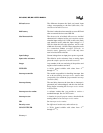
Glossary-3
GLOSSARY
deassert The act of making a signal inactive (disabled). The
polarity (high or low) is defined by the signal name.
Active-low signals are designated by a pound symbol
(#) suffix; active-high signals have no suffix. To
deassert RD# is to drive it high; to deassert ALE is to
drive it low.
differential nonlinearity The difference between the actual code width and the
ideal one-LSB code width of the terminal-based
characteristic of an A/D converter. It provides a
measure of how much the input voltage may have
changed in order to produce a one-count change in the
conversion result. Differential nonlinearity is a
measure of local code-width error; nonlinearity is a
measure of overall code-transition error.
doping The process of introducing a periodic table Group III
or Group V element into a Group IV element (e.g.,
silicon). A Group III impurity (e.g., indium or
gallium) results in a p-type material. A Group V
impurity (e.g., arsenic or antimony) results in an n-
type material.
double-word Any 32-bit unit of data.
DOUBLE-WORD An unsigned, 32-bit variable with values from 0
through 2
32
–1.
EPA Event processor array. An integrated peripheral that
provides high-speed input/output capability.
EPROM Erasable, programmable read-only-memory.
ESD Electrostatic discharge.
feedthrough The attenuation from an input voltage on the selected
channel to the A/D output after the sample window
closes. The ability of the A/D converter to reject an
input on its selected channel after the sample window
closes.
FET Field-effect transistor.
frequency generator The 8XC196MD peripheral that generates outputs
with a fixed 50% duty cycle and a programmable
frequency. The frequency generator can be used for
infrared transmission.


















